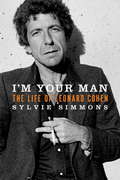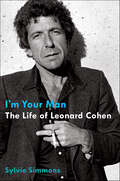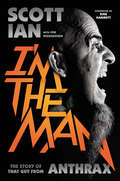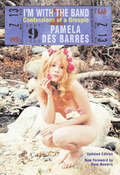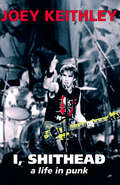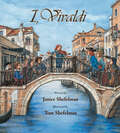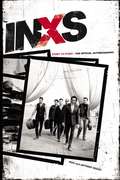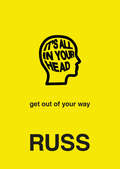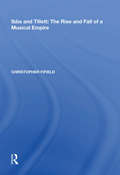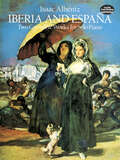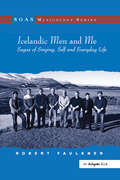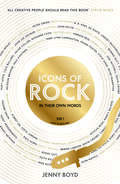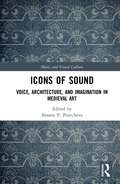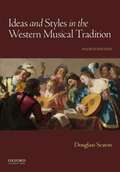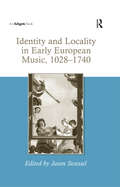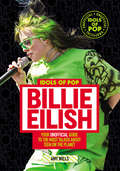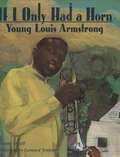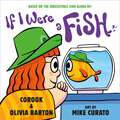- Table View
- List View
I'm Your Man
by Sylvie SimmonsThe definitive biography of one of the most emigmatic, beloved, and celebrated artists of our time. Leonard Cohen's extensive and successful recent worldwide tour has demonstrated that his popularity across generations and borders has never been greater. Cohen's life is one of singular mystique. This major in-depth biography is the book Cohen's fans have been waiting for. Acclaimed writer/journalist Sylvie Simmons has interviewed more than 100 figures from Cohen's life and work, including his main muses; the women in his life -- from Suzanne and Marianne to Rebecca de Mornay and Anjani Thomas; artists such as Rufus Wainwright, Nick Cave, David Crosby, Judy Collins, and Philip Glass; his record producers; his closest friends, from childhood to adulthood; and many of the spiritual figures who have influenced his life.Cohen, notoriously private, has granted interviews himself. Thoroughly researched and thoughtful, penetrating and lively, fascinating and revealing of stories and facts never read before, I'm Your Man offers new perspectives on Cohen and his life. It will be one of the most talked-about books of the season, and for years to come.From the Hardcover edition.
I'm Your Man: The Life of Leonard Cohen
by Sylvie Simmons“The major, soul-searching biography that Leonard Cohen deserves [from] a seasoned rock journalist" (Janet Maslin, New York Times).Leonard Cohen is one of the most important and influential musical artists of the past fifty years—and one of the most elusive. In I’m Your Man, journalist Sylvie Simmons, one of the foremost chroniclers of the world of rock ’n’ roll and popular music, explores the legendary singer/songwriter’s extraordinary life and creative genius.I’m Your Man is an intimate and insightful appreciation of the man responsible for “Suzanne,” “Bird on a Wire,” “Hallelujah,” and so many other unforgettable, oft-covered ballads and songs. Based on Simmons’s unparalleled access to Cohen—and written with her hallmark blend of intelligence, integrity, and style—I’m Your Man is the definitive biography of a major musical artist widely considered in a league with the great Bob Dylan.Readers of Life by Rolling Stone Keith Richards and Patti Smith’s phenomenal Just Kids will be riveted by this fascinating portrait of a singular musical icon.
I'm in the Band!
by Ben HoshkoHave you ever wondered why joining a band is important? It&’s not just about becoming smarter. A band is a welcoming community where everyone can learn the language of music. It&’s a place to develop new skills and express yourself through an instrument. In the band, you create music that can be beautiful, sad, fun, or crazy, and you get to share it with others, sparking new ideas.Whether you&’re marching in a parade, playing in a concert, or performing a solo for your grandparents, being in a band lets you communicate your emotions. It&’s a team effort where everyone works together to create beauty and art. Being in a band gives you a sense of belonging to something amazing. It&’s a place to make lifelong friends, travel, embark on wild adventures, and create incredible memories.
I'm the Man: The Story of That Guy from Anthrax
by Jon Wiederhorn Scott IanThe long-awaited and vastly entertaining autobiography of Scott Ian, guitarist and founder of groundbreaking and influential thrash metal legend Anthrax
I'm with the Band: Confessions of a Groupie
by Dave Navarro Pamela Des BarresThe stylish, exuberant, and remarkably sweet confession of one of the most famous groupies of the 1960s and 70s is back in print in this new edition that includes an afterword on the author's last 15 years of adventures. As soon as she graduated from high school, Pamela Des Barres headed for the Sunset Strip, where she knocked on rock stars' backstage doors and immersed herself in the drugs, danger, and ecstasy of the freewheeling 1960s. Over the next 10 years she had affairs with Mick Jagger, Jimmy Page, Keith Moon, Waylon Jennings, Chris Hillman, Noel Redding, and Jim Morrison, among others. She traveled with Led Zeppelin; lived in sin with Don Johnson; turned down a date with Elvis Presley; and was close friends with Robert Plant, Gram Parsons, Ray Davies, and Frank Zappa. As a member of the GTO's, a girl group masterminded by Frank Zappa, she was in the thick of the most revolutionary renaissance in the history of modern popular music. Warm, witty, and sexy, this kiss-and-tell-all stands out as the perfect chronicle of one of rock 'n' roll's most thrilling eras.
I, Doll: Life and Death with the New York Dolls
by Arthur Killer KaneWhen the New York Dolls' bassist died suddenly at age 55 in 2004, he left behind not only their timeless music--and many thousands of fans and friends--but a memoir of the Dolls' early years. This distinctive and extroverted voice of an undisciplined showman is presented with an introduction and epilogue by his widow, Barbara. This up close and personal perspective of the band's early days and late nights--including an instance where he locks himself out of the studio in full drag while tripping on LSD--chronicles the glorious, glamorous era of high times, high drama, and low comedy that captures the music, the style, and the life of the all-too-brief existence of the New York Dolls.
I, Shithead
by Joey Keithley Jack RabidJoey Keithley, aka Joey Shithead, founded legendary punk pioneers D.O.A. in 1978. Punk kings who spread counterculture around the world, they've been cited as influences by the Red Hot Chili Peppers, Green Day, Rancid and The Offspring; have toured with The Clash, The Ramones, The Dead Kennedys, Black Flag, Nirvana, PiL, Minor Threat and others; and are the subject of two tribute albums. They are the band that introduced the term "hardcore" into punk lexicon and may have turned Nirvana's lead singer Kurt Cobain onto a career in music.But punk is more than a style of music: it's a political act, and D.O.A. have always had a social conscience, having performed in support of Greenpeace, women's rape/crisis centres, prisoner's rights, and antinuke and antiglobalization organizations. Twenty-five years later D.O.A. can claim sales of hundreds of thousands of copies of their 11 albums and tours in 30 different countries, and they are still going strong.I, Shithead is Joey's personal, no-bullshit recollections of a life in punk, starting with the burgeoning punk movement and traversing a generation disillusioned with the status quo, who believed they could change the world: stories of riots, drinking, travelling, playing and conquering all manner of obstacles through sheer determination.Praise for D.O.A.:"They rock out. They blow the roof off. Some of the best shows I've seen in my life were D.O.A. gigs. I've never seen D.O.A. not be amazing."--Henry Rollins (Black Flag, Rollins Band)"The proper medicine growing young minds needed."--Jello Biafra (Dead Kennedys)"Joey Shithead casts a long shadow."--John Doe (X)"They've changed a lot of people's lives."--Dave Grohl (Nirvana, Foo Fighters)Joey "Shithead" Keithley has long been an activist, including as a candidate for the Green Party, and is the founder of Sudden Death Records (www.suddendeath.com). He lives in Vancouver with his wife and their three children.
I, Vivaldi (Incredible Lives for Young Readers (ILYR))
by Janice ShefelmanIn this dynamic picture-book biography, told as if by Vivaldi himself, the famous musician's energetic personality and steadfast dedication to music come alive.Despite his mother's vow for him to become a priest, young Vivaldi is only interested in music. He soon grows from a feisty boy who wants to play the violin into a stubborn young man who puts his musical training ahead of his studies for priesthood.Beautiful, ornate artwork portrays the spirit and splendor of Vivaldi's hometown, Venice. A historical note, musical score, and glossary will help readers more fully appreciate Vivaldi's life and musical genius.
INXS: Story to Story
by Anthony Bozza Inxs PublicationsTHE REAL STORY BEHIND INXS'S RISE TO FAME -- AND HOW THEY HELPED DEFINE THE MUSIC OF A GENERATION. INXS broke new musical ground. This Australian band, made up of three brothers and their three best mates, took the world by storm, turning rock, pop, and funk into a cutting edge, danceable style, and selling more than thirty million albums worldwide. INXS: Story to Story tells the tale of their incredible journey, from playing the world's biggest concert venues to living a high life rivaling any in rock history, filled with sex, drugs, and supermodels. Now for the first time, they reveal everything they experienced in their more than two decades of making music -- the partying, the pressure, the wild times on the road, the heights and depths of rock-star life, and the bonds of brotherhood and friendship that not only got them through the tough times but made the fun times even more intense. They also talk about the sadness of watching their closest friend and collaborator, Michael Hutchence, slipping away from them, and share their thoughts about why he left them far too soon. Fully authorized and reflecting the band's firsthand point of view, this is the real story behind the phenomenon that is INXS -- and the book every rock fan will need to own.
IO, ELVIS: Condannato dal successo.
by Lázaro Droznes Barbara BertoliniElvis Presley fu un personaggio incredibile, che rimane tuttora un punto di riferimento nel panorama musicale mondiale. La sua vita è costellata di successi, ma il ritmo frenetico e l'intensità con cui la vivette l'artista lo portarono alla sua prematura fine. In questa biografia Elvis ci racconta la sua storia, senza tralasciare nulla. Lo fa parlandoci in modo schietto e usando come intermezzo le sue canzoni. Un essere umano straordinario travolto dall'enorme successo e dalla fama, la cui storia ci insegna che una leggenda non muore mai.
IT'S ALL IN YOUR HEAD: Get Out Of Your Way
by RussAn inspirational book by self-made musical superstar, Russ, reminding you that it starts with YOU, to believe in yourself, and to get out of your own way.Twenty-six-year-old rapper, songwriter, and producer Russ walks his own path, at his own pace. By doing so, he proved that he didn’t need a major label to surpass over a billion streams on Spotify/Apple Music, get on Forbes’ 2019 “30 Under 30,” make the Forbes‘ “30 Under 30 Cash Kings” at number 20 for most earned, sell out arenas across the U.S. and around the globe, and become one of the most popular and engaged rappers right now. His method was simple: love and believe in yourself absolutely and work hard no matter what. In this memoir, Russ inspires readers to walk to their individual rhythms and beat their biggest obstacles: themselves.With chapters named after his most powerful and popular songs, IT'S ALL IN YOUR HEAD will reflect on the lessons he’s learned from his career, family, and relationships. He’ll push readers to bet on themselves, take those leaps of faith, and recognize struggles as opportunities. With illustrations throughout consistent with the brand Russ has built and his fan base loves, IT'S ALL IN YOUR HEAD will give readers an inside-look at the man and the motivation behind the music. A lover of books like The Alchemist and The Seven Spiritual Laws of Success, Russ delivers a short, potent, inspirational, raw, and honest book that gives readers a way to find self-belief and unlock their potential. Fans already rely on Russ as an inspiration of confidence; now, he is taking it to the next level with this book, which will contain lyrics from his music and visuals that reflect his inimitable style.
Ibbs and Tillett: The Rise and Fall of a Musical Empire
by Christopher FifieldFor the greater part of the twentieth century, Ibbs and Tillett's concert agency was to the British music industry what Marks and Spencer is to the world of the department store. The roll-call of famous musicians on its books was unmatched, and included such international stars as Clara Butt, Fritz Kreisler, Pablo Casals, Sergei Rachmaninov, Andr Segovia, Kathleen Ferrier, Myra Hess, Jacqueline du Pr Clifford Curzon and Vladimir Ashkenazy, to name but a handful. From 1906, the success of the company was due to the dedication of its founders, Robert Leigh Ibbs and John Tillett. After their deaths, the agency was run by the latter's wife, Emmie, who, dubbed the 'Duchess of Wigmore Street', became one of the most formidable yet respected women in British music. The history of this unique institution and its owners is told here for the first time, often through the fascinating letters that were exchanged between the artists themselves and the agency. It begins in the latter years of the 19th century with the concert and theatrical manager Narciso Vert, for whom both Ibbs and Tillett worked until his death in 1905. The story then becomes a history of musical life in twentieth-century Britain, illuminating aspects of the day-to-day management of concerts and festivals, the lives and livelihoods of professional musicians, as well as those who strove to join their ranks through audition or recommendation. The changing profile, and particularly the onset and development of personal management of artists represented by Ibbs and Tillett and their reception in the press, can be viewed as a barometer of musical taste. The demise of the agency in 1990 was indicative of just how much the world of British music had changed by the end of the century, but despite its loss to the profession, the legacy and influence of Ibbs and Tillett has remained a benchmark in today's highly competitive world of artist management and concert promotion, many of whose principal operators began
Iberia and España: Two Complete Works for Solo Piano (Dover Classical Piano Music)
by Isaac AlbénizIsaac Albéniz (1860-1909) began his musical life as a piano prodigy in Barcelona at the age of four, and it is as a prolific composer of solo works for the pianoforte that we celebrate him most. This inexpensive Dover edition, designed to give you a lifetime of musical enjoyment, presents two of Albéniz's best-known works in authoritative editions: the piano suite Iberia, generally considered to be his masterpiece; and España, which contains the "Tango," his most popular individual work.Iberia is a collection of twelve musical scenes of Spanish life, principally Andalusian, written in the years from 1906 to 1909. Its brilliant and complex character is suffused with the rhythms and harmonies of Spanish popular music, to which Albéniz turned for inspiration in the last years of his life.España, an earlier work first published in 1890, is made up of six piano pieces that subtly reflect the influences of the piano literature of the nineteenth-century salon and -- like Iberia -- the harmony and style of impressionism, which Albéniz himself helped to create. Both works reveal characteristics of the highly individualized piano technique Albéniz developed from early childhood and perfected under the tutelage of Liszt.
Icelandic Men and Me: Sagas of Singing, Self and Everyday Life (SOAS Studies in Music)
by Robert FaulknerA sparsely populated island in the North Atlantic recently made worldwide headlines in the Global Financial Crisis and for volcanic eruptions that caused unprecedented chaos to international air travel. Large contemporary audiences have formed very different images of Iceland through the vocal music and music videos of Björk and Sigur Rós. Just below the Arctic Circle, Icelandic men engage in more everyday vocal practices, where singing, literally for one's Self, is an everyday life skill set against a backdrop of unique natural, historical, economic and social phenomena. Their sagas of song and singing are the subject of this book. The original Icelandic Sagas - among the most important collections of medieval European literature - are valued for richly detailed portrayals of individual lives. This book's principle protagonists and collaborators share a heritage where Sagas remain central to national and local identity. While the oral traditions associated with them were largely overwhelmed by European romanticism just over a hundred years ago, ironically, this new vocal music became a key technology for national renewal. Written by an ’immigrant’ musician who lived in a remote Icelandic community for over twenty years, this volume focuses upon individual and collective stories about singing as personal and social work. Drawing upon everyday ethnographic and sociological studies of music, and emerging discourse about musical identity, the study uses anthropological, historical and musicological evidence in thinking about songs, singing and Self, and the genderedness of this particular singing practice.
Icons of Rock: In Their Own Words
by Jenny BoydThe Creative Process Behind Rock Music#1 New Release in Actor, Entertainer Biographies, and SongwritingWhat inspires the heart, mind, and soul of so many famous rock stars? Human behavior psychologist and 1960s icon Jenny Boyd explores the artistic drive responsible for creating your favorite songs.A glimpse into the creative power of music. Ever since the Beatles’ British Invasion, numerous rock bands and singers have created albums that still have many fans’ love and devotion today. Was it raw talent, or was there something below the surface that transformed these dreamers into Hollywood legends? Icons of Rock invites music lovers to discover the truth behind their favorite artists and how they created the best songs of all time. Investigating the psychology and chemistry behind artistic inspiration, you will find how much an unconscious influence can change not only one person’s life, but the entire world.Rock legends share their inspirational tips for music success. Having experienced a life full of rock and roll, author Jenny Boyd explores the psychology of rock stars not just from a scientific point, but also from the musicians themselves. Inside, you’ll find rock and roll biographies full of what drove your favorite singers and bands into stardom. Featuring interviews and inspiring stories from Stevie Nicks, Ringo Starr, Keith Richards, and more, discover what makes a rock star and how you can find your own creative success by listening to your inner muse.Inside Icons of Rock, you’ll also discover:Why the unconscious is the key to successWays musicians have nurtured their creative processHow peak experiences can manifest in songwriting and concertsIf you liked The Singers Talk, Jennifer Juniper, or Self-Belief Is Your Superpower, you’ll love Icons of Rock.
Icons of Sound: Voice, Architecture, and Imagination in Medieval Art (Music and Visual Culture)
by Bissera V. PentchevaIcons of Sound: Voice, Architecture, and Imagination in Medieval Art brings together art history and sound studies to offer new perspectives on medieval churches and cathedrals as spaces where the perception of the visual is inherently shaped by sound. The chapters encompass a wide geographic and historical range, from the fifth to the fifteenth century, and from Armenia and Byzantium to Venice, Rome, and Santiago de Compostela. Contributors offer nuanced explorations of the importance of intangible sonic aura to these spaces, including the temporal and performative nature of ritual music, as well as the use of digital technology to reconstruct historical aural environments. Rooted in a decade-long interdisciplinary research project at Stanford University, Icons of Sound expands our understanding of the inherently intertwined relationship between medieval chant and liturgy, the acoustics of architectural spaces, and their visual aesthetics. Together, the contributors provide insights that are relevant across art history, sound studies, musicology, and medieval studies.
Ideas and Styles in the Western Musical Tradition
by Douglass SeatonIdeas and Styles in the Western Musical Tradition, Fourth Edition, explores the conceptual frameworks that have shaped musical development from antiquity to the present. In a lively narrative that prompts readers to think both critically and creatively, Douglass Seaton uses historical documents from thinkers, artists, and musicians to add rich detail to the compelling story of Western music. This brief and accessible narrative of music history features numerous works of art, literature, and music that immerse students in the historical and intellectual contexts of musical styles.
Identifying and Interpreting Incongruent Film Music (Palgrave Studies in Audio-Visual Culture)
by David IrelandThis book explores the concept of incongruent film music, challenging the idea that this label only describes music that is inappropriate or misfitting for a film’s images and narrative. Defining incongruence as a lack of shared properties in the audiovisual relationship, this study examines various types of incongruence between a film and its music and considers the active role that it can play in the construction of a film’s meaning and influencing audience response. Synthesising findings from research in the psychology of music in multimedia, as well as from ideas sourced in semiotics, film music, and poststructuralist theory, this interdisciplinary book provides a holistic perspective that reflects the complexity of moments of film-music incongruence. With case studies including well-known films such as Gladiator and The Shawshank Redemption, this book combines scene analysis and empirical audience reception tests to emphasise the subjectivity, context-dependency, and multi-dimensionality inherent in identifying and interpreting incongruent film music.
Identity and Diversity in New Music: The New Complexities (CMS Emerging Fields in Music)
by Marilyn NonkenIdentity and Diversity in New Music: The New Complexities aims to enrich the discussion of how musicians and educators can best engage with audiences, by addressing issues of diversity and identity that have played a vital role in the reception of new music, but have been little-considered to date. Marilyn Nonken offers an innovative theoretical approach that considers how the environments surrounding new music performances influence listeners’ experiences, drawing on work in ecological psychology. Using four case studies of influential new music ensembles from across the twentieth century, she considers how diversity arises in the musical environment, its impact on artists and creativity, and the events and engagement it makes possible. Ultimately, she connects theory to practice with suggestions for how musicians and educators can make innovative music environments inclusive.
Identity and Locality in Early European Music, 1028-1740
by Jason StoesselThis collection presents numerous discoveries and fresh insights into music and musical practices that shaped distinctly localized individual and collective identities in pre-modern and early modern Europe. Contributions by leading and emerging European music experts fall into three areas: plainchant traditions in Aquitania and the Iberian peninsula during the first 700 years of the second millennium; late medieval musical aesthetics, traditions and practices in Paris, Padua, Prague and more generally England, Germany and Spain; and local traditions in Renaissance Augsburg and Baroque Naples and Dresden. In addition to in-depth readings of anonymous musical traditions, contributors provide new details concerning the lives and music of well-known composers such as Ad r de Chabannes, Bartolino da Padova, Ciconia, Josquin, Senfl, Alessandro Scarlatti, Heinichen and Zelenka. This book will appeal to a broad range of readers, including chant scholars, medievalists, music historians, and anyone interested in music's place in pre-modern and early modern European culture.
Idols of K-Pop: Your Must-Have Guide to Who's Who
by Malcolm MackenzieWhether you’re new to K-Pop or a die-hard super stan, Idols of K-Pop is your essential guide to the current K-Pop scene. This unofficial guide features the biggest names in the Korean music genre, including BTS, Blackpink, Twice, Exo, and many more.This guide contains 64 full-color pages all about the world of K-Pop, with up-close photos of the idols, facts, personal info and gossip, candid commentary, and so much more!
Idols of Pop: Your Unofficial Guide to the Most Talked About Teen on the Planet (Idols of Pop)
by Amy WillsBook three in the Idols of Pop series, Idols of Pop: Billie Eilish, is an essential fan-focused guide to the latest and greatest icon in pop music: Billie Eilish!This 64-page book features full-color candid and professional photos with the singer front and center. Packed with personal takes on life, love, music and more, Idols of Pop: Billie Eilish is your guide to one of the hottest pop stars in the world right now
If Beale Street Could Talk: Music, Community, Culture
by Robert CantwellDemonstrating the intimate connections among our public, political, and personal lives, these essays by Robert Cantwell explore the vernacular culture of everyday life. A keen and innovative observer of American culture, Cantwell casts a broad and penetrating intelligence over the cultural functioning of popular texts, artifacts, and performers, examining how cultural practices become performances and how performances become artifacts endowed with new meaning through the transformative acts of imagination. Cantwell's points of departure range from the visual and the literary--a photograph of Woody Guthrie, or a poem by John Keats--to major cultural exhibitions such as the World's Columbian Exposition. In all these domains, he unravels the implications for community and cultural life of a continual migration, transformation, and reformulation of cultural content.
If I Only Had A Horn: Young Louis Armstrong
by Roxane OrgillFrom the book: There was a poor boy in New Orleans who was in love with music. And music was everywhere in his city -- dancing out of doorways, singing on street corners, best of all there was the great Joe Oliver's cornet crying wah-wah for all to hear. If I only had a horn, that boy thought, I too could sing, bring home pennies, and most of all tap happy feet blues till the sun rose. It wasn't going to be easy. Many things, not all of them good, had to happen before that boy got his horn. But when at last he did, his cornet would send music spiraling up into the New Orleans night sky like a spinning top gone crazy.
If I Were a Fish
by Corook Olivia BartonFrom the creators of the viral hit song that is a joyous celebration about making the best of a very bad day comes If I Were a Fish - a gorgeously illustrated picture book explosion of positivity and love guaranteed to make you smile.From the musicians and viral TikTok creators of If I Were A Fish, Corook and Olivia Barton, comes a delightful picture book adaptation of their silly, happy song. Join Corook and Olivia as they grab a guitar and dive into the comforting world of what it might be like to be a fish instead, and together, they make the best of a bad day. Humans and fish alike are welcome to sing (or kazoo) along!How lucky are we?Of all the fish in the seaYou get to be you!And I get to be me!Brightly and beautifully illustrated by the award-winning Mike Curato, this inspiring song about surrounding yourself with the people that make you the happiest is a timely reminder that it’s always best to be yourself.
